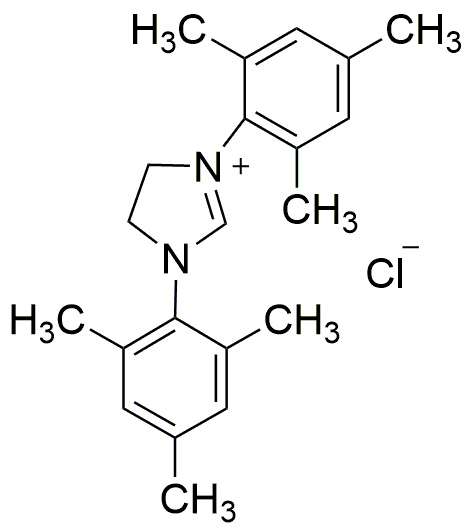1,3-Bis(2,4,6-trimethylphenyl)imidazolinium chloride is widely utilized in research focused on:
- Photoinitiators in Polymer Chemistry: This compound serves as an effective photoinitiator for UV-curable coatings and inks, enhancing the curing process and improving the durability of the final product.
- Organic Synthesis: It acts as a catalyst in various organic reactions, facilitating the formation of complex molecules, which is crucial in pharmaceutical development and fine chemical production.
- Electrochemical Applications: The compound is used in the development of advanced materials for batteries and supercapacitors, contributing to improved energy storage solutions.
- Biological Research: It has potential applications in biological assays and drug discovery, where its unique properties can help in the development of new therapeutic agents.
- Material Science: This chemical is explored for its role in creating high-performance materials, such as conductive polymers, which are essential in electronics and sensor technologies.
General Information
Properties
Safety and Regulations
Applications
1,3-Bis(2,4,6-trimethylphenyl)imidazolinium chloride is widely utilized in research focused on:
- Photoinitiators in Polymer Chemistry: This compound serves as an effective photoinitiator for UV-curable coatings and inks, enhancing the curing process and improving the durability of the final product.
- Organic Synthesis: It acts as a catalyst in various organic reactions, facilitating the formation of complex molecules, which is crucial in pharmaceutical development and fine chemical production.
- Electrochemical Applications: The compound is used in the development of advanced materials for batteries and supercapacitors, contributing to improved energy storage solutions.
- Biological Research: It has potential applications in biological assays and drug discovery, where its unique properties can help in the development of new therapeutic agents.
- Material Science: This chemical is explored for its role in creating high-performance materials, such as conductive polymers, which are essential in electronics and sensor technologies.
Documents
Safety Data Sheets (SDS)
The SDS provides comprehensive safety information on handling, storage, and disposal of the product.
Product Specification (PS)
The PS provides a comprehensive breakdown of the product’s properties, including chemical composition, physical state, purity, and storage requirements. It also details acceptable quality ranges and the product's intended applications.
Certificates of Analysis (COA)
Search for Certificates of Analysis (COA) by entering the products Lot Number. Lot and Batch Numbers can be found on a product’s label following the words ‘Lot’ or ‘Batch’.
*Catalog Number
*Lot Number
Certificates Of Origin (COO)
This COO confirms the country where the product was manufactured, and also details the materials and components used in it and whether it is derived from natural, synthetic, or other specific sources. This certificate may be required for customs, trade, and regulatory compliance.
*Catalog Number
*Lot Number
Safety Data Sheets (SDS)
The SDS provides comprehensive safety information on handling, storage, and disposal of the product.
DownloadProduct Specification (PS)
The PS provides a comprehensive breakdown of the product’s properties, including chemical composition, physical state, purity, and storage requirements. It also details acceptable quality ranges and the product's intended applications.
DownloadCertificates of Analysis (COA)
Search for Certificates of Analysis (COA) by entering the products Lot Number. Lot and Batch Numbers can be found on a product’s label following the words ‘Lot’ or ‘Batch’.
*Catalog Number
*Lot Number
Certificates Of Origin (COO)
This COO confirms the country where the product was manufactured, and also details the materials and components used in it and whether it is derived from natural, synthetic, or other specific sources. This certificate may be required for customs, trade, and regulatory compliance.


